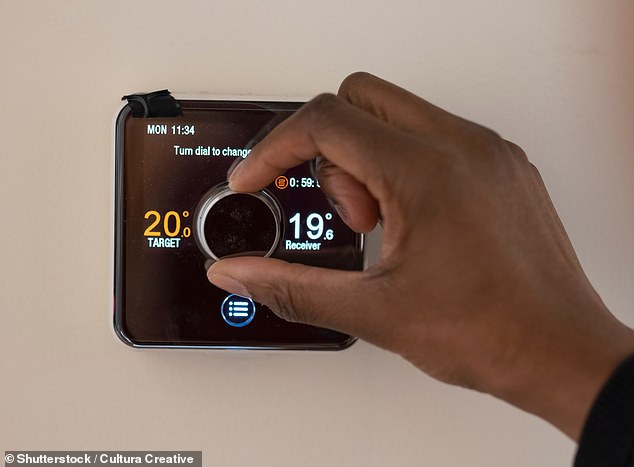It’s something that millions of households squabble over every winter – what temperature should you set your home thermostat at?
Now, a survey of 2,000 Britons has settled the debate once and for all.
According to the research, the ideal temperature for your home is 19.5°C (67.1°F).
While this might sound chilly to many people, the World Health Organisation (WHO) actually recommends an even lower temperature of 18°C (64.4°F).
‘Indoor housing temperatures should be high enough to protect residents from the harmful health effects of cold,’ the WHO explains.
‘For countries with temperate or colder climates, 18°C has been proposed as a safe and well-balanced indoor temperature to protect the health of general populations during cold seasons.’
However, certain vulnerable groups may require a higher thermostat temperature, according to the WHO.
‘A higher minimum indoor temperature than 18°C may be necessary for vulnerable groups including older people, children and those with chronic illnesses, particularly cardiorespiratory disease,’ it added.

It’s something that millions of households squabble over every winter – what temperature should you set your home thermostat at? Now, a survey of 2,000 Britons has settled the debate once and for all (stock image)
For the new survey, LoftZone asked 2,000 Britons about their heating habits ahead of winter.
The results revealed that more than a quarter (28 per cent) of Britons regularly argue with their partner about the heating.
Meanwhile, 18 per cent get frustrated with other family members who adjust the temperature.
With energy costs continuing to rise in the UK, it comes as no surprise that a whopping 96 per cent of people are constantly turning down the heating to save cash.
And two thirds (66 per cent) said they’re worrying about how they are going to pay for heating this winter.
‘The energy crisis remains a pressing concern, with many Brits worried about heating their homes, or their families’ homes this winter,’ said LoftZone’s CEO, Dave Raval.
While this survey suggests that 19.5°C (67.1°F) is the ideal home temperature, experts have previously recommended slightly different temperatures.
For example, the WHO recommends 18°C, while the Energy Saving Trust recommends heating your home to between 18°C and 21°C during winter.

According to the research, the ideal temperature for your home is 19.5°C (67.1°F). While this might sound chilly to many people, the World Health Organisation (WHO) actually recommends an even lower temperature of 18°C (64.4°F)
‘If you can, turning down your thermostat from 22°C to 21°C can save £90 a year in GB and £100 in NI on energy bills,’ it explains on its website.
If you’re looking for ways to save on your heating bills, Mr Raval has five top tips:
1. Invest in loft insulation
‘Heat rises and in a typical British home 25% of your heat goes out through your ceiling, into your loft and out through the roof,’ he said.
‘Most people have some loft insulation, but you need a lot more that you think.
‘The government recommendation is a minimum is 300 millimetres, which is almost a foot.’
2. Draught-proofing
‘The first thing I would always do in the home is to look for draughts,’ Mr Raval said.
‘Don’t let the money you’ve spent on heating your house seep through the gaps!’
3. Install Thermostatic Radiator Valves
‘If you have radiators, make sure each one has a TRV – a thermostatic radiator valve,’ Mr Raval said.
‘Most homes have one single thermostat controlling your temperature, but many rooms need less heat.’
4. Consider a radiator fan
‘As heat rises, the ceiling gets warm first, then only afterwards does the lower part of the room start to warm up,’ Mr Raval said.
‘To tackle this, why not consider a radiator fan, which you can put on top of a radiator.
‘It simply blows the heat on to you, rather than let it drift upwards, so you feel warmer, sooner.’
5. Save hot water
‘There are obvious things to save water, such as taking quicker showers and having fewer baths, but often people forget the water used whilst washing up,’ Mr Raval explained.
‘Use a bowl, or plug the sink, to avoid washing every item under the hot water tap, that is just heated water you’ve paid for that is going down the plughole!
‘You can rinse cleaned crockery etc with cold water, too.’
This article was originally published by a www.dailymail.co.uk . Read the Original article here. .


